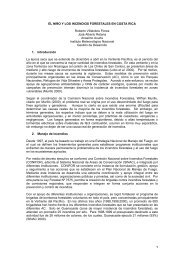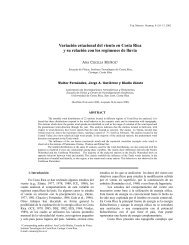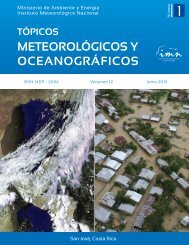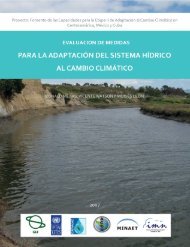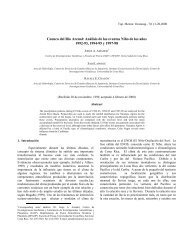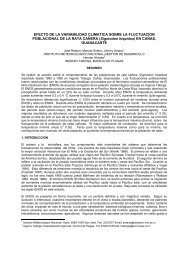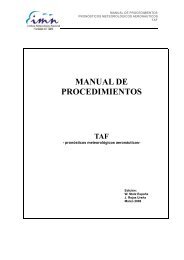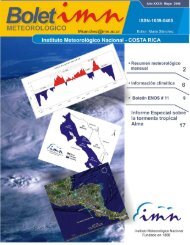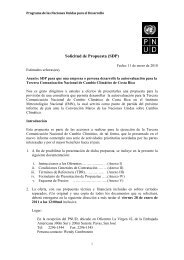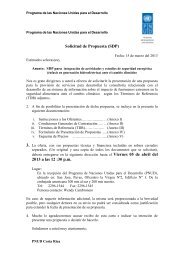descargar Documento - IMN - Instituto Meteorológico Nacional
descargar Documento - IMN - Instituto Meteorológico Nacional
descargar Documento - IMN - Instituto Meteorológico Nacional
You also want an ePaper? Increase the reach of your titles
YUMPU automatically turns print PDFs into web optimized ePapers that Google loves.
22<br />
Efforts to achieve any of the options for carbon<br />
neutrality are significant, in terms of reduction<br />
of fossil fuel energy, as well as associated low<br />
carbon technologies. These efforts will depend<br />
on an economic policy that internalizes costs<br />
and other suggested measures included in the<br />
IPCC Policy Proposals by sectors to provide incentives<br />
for changes in the productive sectors.<br />
In order to achieve national goals, a sustained<br />
and coherent support to address priorities and<br />
resources is required, taking into consideration<br />
that the costs will be higher if actions are not<br />
taken right away. A low carbon economy would<br />
generate financial resources that will benefit<br />
ecosystems and reduction of vulnerability to climate<br />
change. For example, energy production<br />
from hydrological sources will provide clean<br />
energy, at the same time, will protect water<br />
resources to the effects of climate change and<br />
generation of energy.<br />
The National Carbon Neutral Policy stated by<br />
Costa Rica is a defiant challenge. It offers valuable<br />
opportunities for the country’s economic,<br />
environmental and social development. Delay<br />
actions will impose higher costs in the future according<br />
to estimates and International reports.<br />
Taking actions now will facilitate a head start<br />
and build national capacities to become a low<br />
and neutral carbon emission economy. This is<br />
an effort of our society to be responsible with<br />
future generations and as a valuable effort to<br />
preserve the functions of ecosystem that provide<br />
support to our life.<br />
Assessment of vulnerability, effects<br />
of climate change, and adaptation<br />
measures<br />
Costa Rica is a country vulnerable to extreme hydrometeorological<br />
events, which have brought<br />
disaster to many of its socioeconomic sectors.<br />
The following section characterizes climate,<br />
variability, and climate change, and is an important<br />
guide towards the understanding of current<br />
and future climate, crucial in the design of a National<br />
Adaptation to Climate Change Strategy.<br />
Costa Rica’s Climate Regions<br />
The Northwest-Southeast orientation of its mountain<br />
range system divides Costa Rica into two regions:<br />
Pacific and Caribbean. Each one of these<br />
regions has its own precipitation regime, with<br />
particular spatial and temporal characteristics.<br />
The two precipitation regimes, mountain distribution,<br />
along with Costa Rica’s prevailing<br />
winds and oceanic influence, differentiate three<br />
main climate regions, which are divided into six<br />
smaller scale zones: the Humid Tropical Region<br />
of the Caribbean (to which belong the Northern<br />
Zone and Caribbean Region), the Inter-mountainous<br />
Central Region (to which belongs the<br />
Central Region), and the Tropical Pacific Region<br />
(which is made up by the North Pacific, Central<br />
Pacific and South Pacific Regions).<br />
Signs of climate change in Costa Rica<br />
Table i.3 provides examples of recent events<br />
which suggest changes Costa Rica’s climate.<br />
Future climate projections in<br />
Costa Rica<br />
Future climate projections obtained through the<br />
PRECIS model quantitative results are presented<br />
in the following images.<br />
II Comunicación <strong>Nacional</strong> 2009



